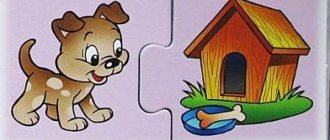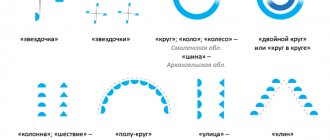Card index of games for the development of sound culture of speech (junior group)
Junior group
Goals: to develop phonemic hearing, speech attention, speech breathing, to consolidate the correct pronunciation of sounds and words.
Exercise “Blow on the fluff”
Children stand in a circle, the teacher gives them fluff. He suggests blowing on them, saying “Foo-oo-oo,” and watching them fly. Then the children pick up the fallen fluffs. (repeat 5-6 times.)
Material. For each child, a piece of fluff or a rectangle cut out of tissue paper (3x1 cm).
Game "Bear cubs eat honey"
The teacher tells the children that they will be bear cubs, and bear cubs really love honey. He suggests bringing your palm closer to your mouth (with your fingers away from you) and “licking” the honey - the children stick out their tongues and, without touching their palm, imitate that they are eating honey. Then, lifting the tip of the tongue, remove it. (Mandatory demonstration of all actions by the teacher.)
The game is repeated 3-4 times.
Then the teacher says: “The bear cubs are full. They lick their upper lip (show, lower lip {show). They stroke their bellies, saying: “U-oo-oo” (2-3 times)
Game "Let's feed the chicks"
Educator. I am a mother bird, and you are my baby birds. The chicks are cheerful, they squeak: “Pi-pi-pi,” and flap their wings (children repeat the movements after the teacher and pronounce the sound combination).
— The mother bird flew off to get tasty crumbs for her children, and the chicks flew merrily and squeaked. ({Children say: “Pee-pee-pee.”)
— Mom flew in and started feeding her babies {the children crouch down, raise their heads up, the chicks open their beaks wide, they want tasty crumbs {the teacher imitates feeding the chicks, getting the children to open their mouths wider). The mother fed everyone and flew away, and the chicks again fly and squeak. The game is repeated 2-3 times.
Game "Clock"
Educator. Listen to how the clock ticks: “Tick-tock, tick-tock”, how the clock strikes: “Bom-bom.” In order for them to walk, you need to start them: “Trick-Trac.” Let's wind up a big clock (children repeat the corresponding sound combination 3 times); Our clock goes and first ticks, then strikes (sound combinations are repeated by the children 5-6 times). Now let's wind up the small clock, the clock goes and sings quietly, the clock strikes very quietly (the children imitate the ticking and ringing of the clock with their voices each time).
Game “Hit a nail with a hammer”
Educator. When a large hammer knocks, you can hear: “Knock-knock-knock” (children repeat the sound combination 5-6 times). When a small hammer knocks, you can hear: “Bale-buck-buck” {children repeat the sound combination 5-6 times).
Let's hammer the nail in with a big hammer.
Now let's hammer in a small nail with a small hammer.
Close your eyes and listen to which hammer is knocking (without a system, the teacher repeats sound combinations 4-5 times, and the children say which hammer is knocking).
Exercise “At the doctor’s appointment”
Educator. The doll is a doctor. The doctor came to see if any of the children had a sore throat. Whoever the doctor approaches, let him open his mouth wide (children do).
The doctor said that all the children were healthy and no one had a sore throat.
Let's check your teeth, let the doctor see if they hurt you. {Children, together with the teacher, move their tongues over their teeth in a circular motion with their mouths closed and open.)
Whoever the doctor approaches will show his teeth (teeth closed).
The doctor said that everyone’s teeth are healthy.
Material. Toy hare; pictures of a bear, squirrel, elephant, monkey, bird, dog on flannel; flannelograph; one cotton ball for each child; There are two cubes on each table.
Exercise “Kick the ball into the goal”
On each table - on the edge opposite from the children - two cubes (gates) are placed at a distance of 10 cm from each other. Children blow on cotton balls to hit the goal.
Game "Be careful"
Educator. I have different pictures. If I show you a picture of an animal, you must scream as it screams and raise the blue circle. If I show you a toy, you will raise a red circle and name the toy.
The teacher shows pictures (at random, and the children
perform actions.
Exercise “Freeze your hand”
Children bring their hand to their mouth at a distance of about 10 cm and say:
“Foo-oo-oo” - they blow on the hand. Repeat the exercise 4-5 times.
Exercise "Pendulum"
The teacher says that some clocks have a pendulum. It swings (show, and the clock moves. If the pendulum stops, the clock will stand. Our tongues will be pendulums. Open your mouth wider. The tongue will “walk between your teeth (show) Repeat the exercise 3 times. After a short break, do it again.
Game "Guess the word"
Teacher (puts out pictures of animals on a flannelgraph according to the number of children in the group). I will begin to name the animal, and the one I ask will name it correctly. I will say: “Losha. ", and you should say: "Horse" or "horse".
The teacher pronounces the word without the last syllable or sound, the children name the whole word.
Material. Toys: doll, bunny, pyramid, car.
Game “Teach the bear to speak correctly”
Educator. Mishka told me that he doesn’t know how to name toys correctly and asks me to teach him. Let's help him. Bear, what is the name of this toy (shows the doll? (Bear. Doll.) No, wrong. This. (children call the toy in unison). Tell, Lena (names are introduced for ease of presentation, what is the name of this toy. Say, Vova, louder. Bear, now you say it correctly. Well done, you named it correctly. What is the name of this toy, bear (shows the bunny? (Bear. Zak.) Say, Kolya, correctly. (Answer.) Now everyone repeat the word. Bear, now you say it. Similar work carried out with the names of other toys: pyramid (piradka, car (shimina). Material. Toys: doll, bunny, pyramid, car.
Game "Bells Are Ringing"
Educator. The big bell (shows a big circle) rings: “Ding, ding, ding.” The little one (shows a small circle) rings: “Ding, ding, ding” (children repeat the sound combinations). When I show the big circle, the big bells will ring; when I show a small circle, small bells will ring.
The teacher shows either large (3 times) or small (3 times) circles (haphazardly).
Material. Large and small mugs of any color.
Game "Horses and Train"
(in a circle) Teacher. When the horses gallop, you can hear: “Tsok, Tsok, Tsok” (children repeat the sound combination); when the train is moving, the wheels knock: “Chok, chok, chok” (children repeat). The horses galloped. The horses are resting. The train started moving and the wheels rattled. The train stopped. The game is repeated 3 times.
CARD FILE ON SCR IN THE JUNIOR GROUP Methodological development on speech development (junior group) on the topic
Card index of games on ZKR for the second junior group
Didactic game “Guess what it sounds like”
Goal: To introduce children to the sounds of the world around them, to isolate and recognize them.
Progress: The teacher shows the objects one by one and demonstrates how they sound. Then the teacher offers to solve riddles. He closes the screen and acts with different objects, and the children recognize which objects the different sounds belong to. Explains that there are many sounds in the world and they all sound differently.
Didactic game "Clock"
Goal: To develop children's speech attention.
Progress: V-l: Listen to how the clock ticks: “Tick-tock, tick-tock”, how the clock strikes: “Bom-bom...”. In order for them to walk, you need to wind them up: “backgammon…”! .
- Let's wind up a big clock (children repeat the corresponding sound combination 3 times); Our clock goes and first ticks, then strikes (sound combinations are repeated by children 5-6 times).
- Now let’s wind up the small clock, the clock goes and sings quietly, the clock strikes very quietly (the children imitate the movement and ringing of the clock with their voices each time).
Diactic game “Bear cubs eat honey”
Goal: To develop the articulatory apparatus of children.
Progress: The teacher tells the children that they will be bear cubs, and bear cubs really love honey. He suggests bringing your palm closer to your mouth (with your fingers) and “licking” the honey - the children stick out their tongues and, without touching their palm, imitate that they are eating honey. Then, lifting the tip of the tongue, remove it. (mandatory demonstration of all actions by the teacher.)
The game is repeated 3-4 times.
Then the teacher says: “The bear cubs are full. They lick the upper lip (show), lower lip (show). They stroke their tummies, saying: “Oooh” (2-3 times).
Didactic game “Frog and little frogs”
Goal: To develop children's speech attention.
Progress: The teacher divides the children into two groups: large and small frogs. He says: “Big frogs jump into the pond, swim in the water and croak loudly: “Kva-kva” (children imitate that they are swimming and croak loudly).
Little frogs also jump into the pond, swim, and croak quietly (children imitate the actions and croak quietly). All the frogs got tired and sat down on the sand on the shore.” Then the children change roles and the game is repeated.
Didactic game “Let’s feed the chicks”
Goal: To develop the speech apparatus of children.
Progress: (I am the mother bird, and you are my little chicks. The chicks are cheerful, they squeak: “pee-pee,” and flap their wings. The mother bird flew for tasty crumbs for her children, and the chicks fly merrily and squeak The mother arrived and began to feed her children (the children squat down, raise their heads up, the chicks open their beaks wide, they want tasty crumbs. (The teacher tries to get the children to open their mouths wider.) The game is repeated 2-3 times.
Didactic exercise “At the doctor’s appointment”
Goal: To develop the articulatory apparatus of children.
Progress: The doll is a doctor. She wants to see if the children's teeth hurt.
Q: Show the doctor your teeth (the teacher with the doll quickly walks around the children and says that everyone has good teeth. Now the doctor will check if you have a sore throat. Whoever she approaches will open his mouth wide (the children open their mouths wide).
The doctor is happy: no one has a sore throat.
Didactic game “Guess what it sounds like”
Goal: Continue to isolate and recognize the sounds of individual musical instruments.
Procedure: The teacher shows musical instruments one by one and demonstrates how they sound. Then the teacher offers to solve riddles. He closes the screen and acts with different instruments, and the children recognize what different sounds belong to.
Didactic game “Recognize by voice”
Goal: To clarify and reinforce the correct pronunciation of sounds.
Progress: The teacher shows the toys and asks who it is, asks to say how it screams. The screen is closed and one subgroup of children takes the toys and takes turns speaking for their animals. Another group guesses who shouted.
Didactic game “Who lives in the house? »
Goal: To reinforce the correct pronunciation of sounds. Develop children's speech breathing.
Progress: (The teacher shows a picture of a dog). Who is this? The dog barks loudly: “aw-aw.” And who is this? (children's answers) The puppy barks quietly (children repeat the sound combination 3-4 times). (The teacher shows a picture of a cat). Who is this? The cat meows loudly: “Meow-meow.” And who is this? (children's answers) The kitten meows quietly.
Let the little animals go home (the pictures are put away behind the cubes). Guess who lives in this house: “av-av” (pronounced loudly? (children’s answers) That’s right, a dog (shows a picture). How did she bark? (children’s answers).
Guess who lives in this house: “meow-meow” (pronounced quietly? How did the kitten meow?
Similarly, children guess who lives in other houses and repeat sound combinations several times.
Didactic game “Who is screaming? »
Goal: To develop children's speech attention.
Progress: The mother bird had a little chick (puts out pictures). His mother taught him to sing. The bird sang loudly: “chirp - chirp” (children repeat the sound combination). And the chick answered quietly: “chirp-chirp” (children repeat the sound combination 3-4 times). The chick flew and flew far away from its mother (moves the picture of the chick further away). The bird is calling its son. What does she call him? (Children, together with the teacher, repeat the sound combination). The chick heard its mother calling him and chirped. How does he tweet? (Children say quietly). He flew to his mother. The bird sang loudly. How?
Didactic game “Call your mother”
Goal: To reinforce the correct pronunciation of sounds. Develop intonation expressiveness.
Progress: All children have object pictures with baby animals. Educator: “Who is your picture, Kolya? (chicken) Who is the chicken's mother? (chicken) Call your mother, chicken. (Peep-pee-pee) The teacher imitates the clucking of a chicken and shows a picture.
The same work is carried out with all children.
Didactic game “Respond”
Goal: To reinforce the correct pronunciation of sounds. Develop intonation expressiveness.
Progress: Educator: This is a goat (showing a picture). How is she screaming? Who is her cub? How does he scream? This is a sheep (show picture). How does she bleat? And how does her baby lamb scream? etc. Pictures are displayed on flannelgraph.
The teacher hands out pictures of animals and birds to the children. The cubs are walking (children leave the tables, nibble grass, nibble crumbs. Whose mother or whose father will call the cub. He must shout - answer them - and run - put the picture next to them.
The teacher pronounces the cry of an animal or bird. The child with the cub depicted makes sounds and places the picture on the flannelgraph.
Game "Guess what to do"
Target. Teach children to correlate the nature of their actions with the sound of the tambourine. Developing children's ability to switch auditory attention.
Preparatory work. Prepare 2 flags for each child.
Progress: Children sit in a semicircle. Each person has 2 flags in their hands. If the teacher rings the tambourine loudly, the children raise the flags up and wave them; if quietly, they keep their hands on their knees.
Methodical instructions. An adult needs to monitor the correct posture of children and the correct execution of movements; It is necessary to alternate the loud and quiet sound of the tambourine no more than four times so that children can easily perform the movements.
Game "Sun or Rain?"
Target. Teach children to perform actions according to the different sounds of the tambourine. Developing children's ability to switch auditory attention.
Progress: The adult says to the children: “Now you and I will go for a walk. We go for a walk. There is no rain. The weather is good, the sun is shining, and you can pick flowers. You walk, and I will ring the tambourine, you will have fun walking to the sound of it. If it starts to rain, I will start knocking on the tambourine, and when you hear the knock, you must run into the house. Listen carefully when the tambourine rings and when I knock on it.”
Methodical instructions. The teacher conducts the game, changing the sound of the tambourine 3 - 4 times.
Game "Where did they call?"
Target. Teach children to determine the direction of sound. Development of the direction of auditory attention.
Preparatory work. An adult prepares a bell.
Progress: Children sit in a circle. The adult chooses the driver, who stands in the center of the circle. At the signal, the driver closes his eyes. Then the teacher gives one of the children a bell and invites them to call. The driver, without opening his eyes, must indicate with his hand the direction from which the sound is coming. If he points correctly, the adult says: “It’s time,” and the driver opens his eyes, and the one who called raises and shows the bell. If the driver makes a mistake, he guesses again, then another driver is appointed.
Methodical instructions. The game is repeated 4-5 times. You need to make sure that the driver does not open his eyes during the game. Indicating the direction of the sound, the driver turns to face the place from which the sound is heard. The call should not be very loud.







